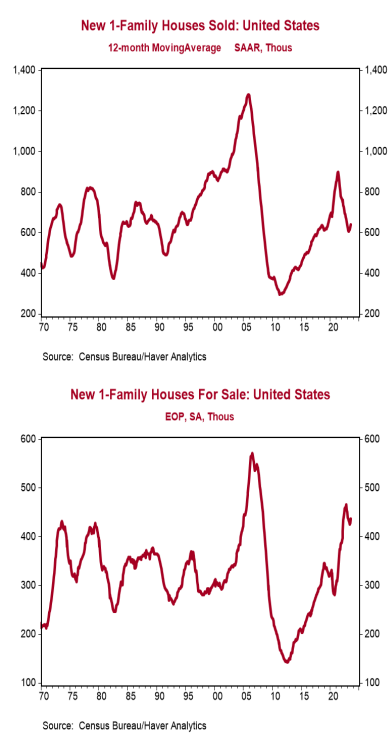- New single-family home sales increased 4.4% in July to a 0.714 million annual rate, beating the consensus expected 0.703 million. Sales are up 31.5% from a year ago.
- Sales in July rose in the Midwest and West but fell in the South and Northeast.
- The months’ supply of new homes (how long it would take to sell all the homes in inventory) declined to 7.3 in July from 7.5 in June. The drop was entirely due to a faster pace of sales. Inventories rose by 9,000 units in July.
- The median price of new homes sold was $436,700 in July, down 8.7% from a year ago. The average price of new homes sold was $513,000, down 9.2% versus last year.
Implications:
New home sales rebounded in July following a small decline the prior month, remaining resilient despite a recent surge in mortgage rates. Sales have been on an upward trend in the past year and are now 31.5% above the low in July of 2022. However, they still remain well below the pandemic highs of 2020. The main issue with the US housing market remains affordability. Assuming a 20% down payment, the rise in mortgage rates since the Federal Reserve began its current tightening cycle amounts to a 29% increase in monthly payments on a new 30-year mortgage for the median new home. With 30-year mortgage rates currently sitting above 7.5% for the first time in two decades, financing costs remain a headwind. The good news for potential buyers is that the median sales price of new homes has fallen by 12.1% from the peak late last year, which has helped sales activity begin to recover. While a lack of inventory had contributed to price gains in the past couple of years, in general, inventories have made substantial gains recently. The months’ supply of new homes (how long it would take to sell the current inventory at today’s sales pace) is now 7.3, up significantly from 3.3 early in the pandemic. Most importantly, the supply of completed single-family homes is up 150% versus the bottom in 2022. This is in contrast to the market for existing homes which continues to struggle with an inventory problem, often due to the difficulty of convincing current homeowners to give up the low fixed-rate mortgages they locked-in during the pandemic. Though not a recipe for a significant rebound, more inventories should continue to help moderate new home prices and put a floor under sales activity. One problem with assessing housing activity is that the Federal Reserve held interest rates artificially low for more than a decade. With rates now in a more normal range, the sticker shock on mortgage rates for potential buyers is very real. However, we have had strong housing markets with rates at current levels in the past, and homebuyers will eventually adjust, possibly by looking at lower priced homes. Finally, we got data on the M2 money supply yesterday which rose 0.1% in July, the third gain in a row following a long string of declines. That said, the money supply is still down 3.7% from a year ago and we are likely to feel the negative economic effects of that in the coming twelve months.





